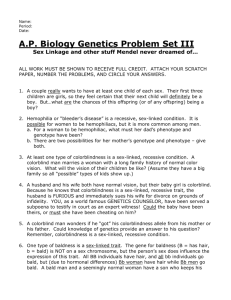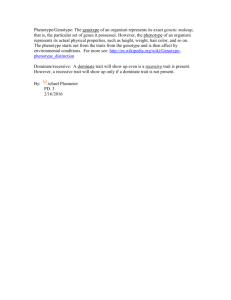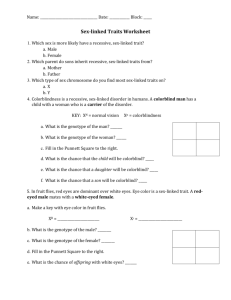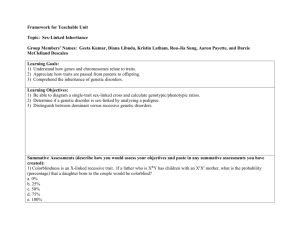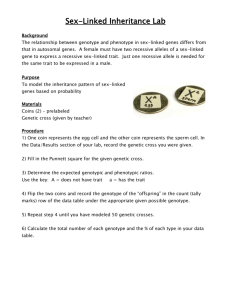Genetics Unit Review & Problem Set - High School Biology
advertisement
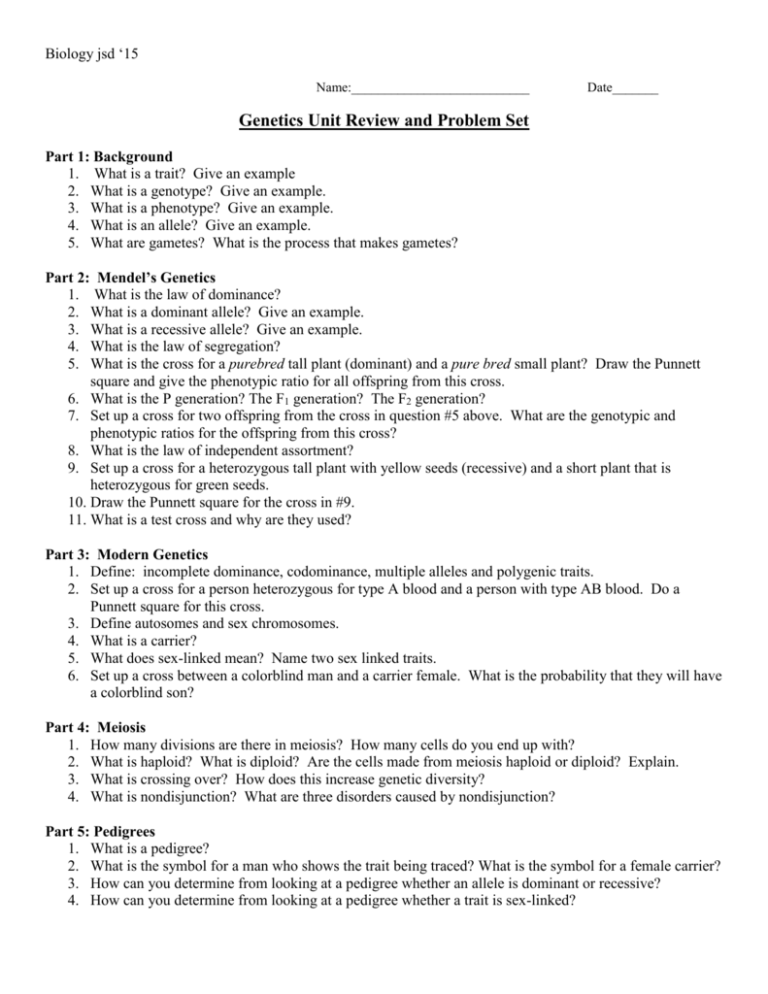
Biology jsd ‘15 Name:___________________________ Date_______ Genetics Unit Review and Problem Set Part 1: Background 1. What is a trait? Give an example 2. What is a genotype? Give an example. 3. What is a phenotype? Give an example. 4. What is an allele? Give an example. 5. What are gametes? What is the process that makes gametes? Part 2: Mendel’s Genetics 1. What is the law of dominance? 2. What is a dominant allele? Give an example. 3. What is a recessive allele? Give an example. 4. What is the law of segregation? 5. What is the cross for a purebred tall plant (dominant) and a pure bred small plant? Draw the Punnett square and give the phenotypic ratio for all offspring from this cross. 6. What is the P generation? The F1 generation? The F2 generation? 7. Set up a cross for two offspring from the cross in question #5 above. What are the genotypic and phenotypic ratios for the offspring from this cross? 8. What is the law of independent assortment? 9. Set up a cross for a heterozygous tall plant with yellow seeds (recessive) and a short plant that is heterozygous for green seeds. 10. Draw the Punnett square for the cross in #9. 11. What is a test cross and why are they used? Part 3: Modern Genetics 1. Define: incomplete dominance, codominance, multiple alleles and polygenic traits. 2. Set up a cross for a person heterozygous for type A blood and a person with type AB blood. Do a Punnett square for this cross. 3. Define autosomes and sex chromosomes. 4. What is a carrier? 5. What does sex-linked mean? Name two sex linked traits. 6. Set up a cross between a colorblind man and a carrier female. What is the probability that they will have a colorblind son? Part 4: Meiosis 1. How many divisions are there in meiosis? How many cells do you end up with? 2. What is haploid? What is diploid? Are the cells made from meiosis haploid or diploid? Explain. 3. What is crossing over? How does this increase genetic diversity? 4. What is nondisjunction? What are three disorders caused by nondisjunction? Part 5: Pedigrees 1. What is a pedigree? 2. What is the symbol for a man who shows the trait being traced? What is the symbol for a female carrier? 3. How can you determine from looking at a pedigree whether an allele is dominant or recessive? 4. How can you determine from looking at a pedigree whether a trait is sex-linked? Biology jsd ‘15 Reviewing Codominance, Multiple Alleles, and Sex-linked Traits 1. In cattle, the alleles for red coat (R) and white coat (Q) behave as the co-dominants. Both red and white hairs are produced in the heterozygote producing a coat pattern that is called "roan." - Give the phenotypic and genotypic ratios to be expected among the offspring from a cross of two roan animals. - What are the expected genotypic and phenotypic ratios from a cross of a roan animal and a white one? 2. The Case of the Suspected Father Blood typing is often used as evidence in paternity cases in courts, but it cannot be used to convict a man, only exonerate him (show that he is not the father!). In a series of disputed paternity cases, the mother and child each had the blood types listed in the table below. For each, indicate the blood types which, if found, would exonerate (free) an accused man. Mother’s Phenotype Possible Genotypes for Mother Child’s Phenotype A O B AB O A AB A O O B B A B Possible Genotypes for Child Man exonerated if he has these phenotype(s) 3. In humans type A blood is caused by the antigen A in the red cells resulting from gene A. Type B is caused by a gene B for antigen B. Type O blood results from the absence of either gene while the presence of both genes causes both antigens to be formed resulting in type AB blood. If a person of blood group AB marries one belonging to blood group O what will be the blood groups of their children? 4. If one parent has Type A blood and the other has type B, but all four blood types are represented among the offspring, what are the genotypes of the parents? 5. If both parents are type A but ¾ of their children are type A and ¼ of the children are type O, what are the parent's genotypes? Biology jsd ‘15 6. What are the likely genotypes of the parents if one has type AB blood and the other type B, but their children are ¼ A, ¼ AB and ½ type B? 7. In a case of disputed paternity, the mother belongs to group B, the child to O, one possible father to A and the other to AB. Which one is the true father of the child? 8. What are the possible blood types of children in the following families? (a) Type A mother, Type A father (b) Type A mother, Type AB father (c) Type AB mother, Type AB father (d) Type A mother, Type B father 9. A type A woman has a baby who has a blood type of O. She claims that one of two men is the father. Man #1 has blood type B. Man #2 has blood type AB. Is it possible to rule out one man as the possible father? Why? Is it possible to prove that one of these men is the father? Why? 10. Hemophilia or “bleeder’s disease” is a recessive, sex-linked condition. It is possible for women to be hemophiliacs, but it is more common among men. a) For a woman to be a hemophiliac, what must her dad’s phenotype and genotype have been? b) There are two possibilities for her mother’s genotype & phenotype – give both. c) Of the 2 possibilities in part b, which one is most likely for the mother? Why? 11. At least one type of colorblindness is a sex-linked, recessive condition. A colorblind man marries a woman with a long family history of normal color vision. What would you predict for the vision of their children? (Genotype and phenotype ratios) 12. A husband and his wife both have normal vision, but their baby girl is colorblind. Because he knows that colorblindness is a sexlinked, recessive trait, the husband is FURIOUS and immediately sues his wife for divorce on grounds of infidelity. YOU, as a world-famous GENETICS COUNSELOR, have been served a subpoena to testify in court as an expert witness! Could the baby have been theirs, or must she have been unfaithful to him? Biology jsd ‘15 13. A colorblind man wonders if he “got” his colorblindness allele from his mother or his father. Can knowledge of genetics provide an answer to his question? Remember, colorblindness is a sex-linked, recessive condition. 14. One type of baldness is a sex-influenced trait. The gene for baldness (B = has hair, b = bald) is NOT on a sex chromosome, but the person’s sex does influence the expression of this trait. All BB individuals have hair, and all bb individuals go bald, but (due to hormonal differences) Bb women have hair while Bb men go bald. A bald man and a seemingly normal woman have a son who keeps his hair as he ages, and a daughter who loses hers. What are the genotypes of the man, his wife, their son, and their daughter? 15. In cats, the allele B leads to black fur and A leads to yellow fur. However, ‘BA’ is tortoise-shell color (both black and yellow). The gene for color is on the X chromosome. A tortoise-shell female is crossed with a black male. (a) What kinds of kittens would be expected? (b) Would you expect to find any tortoise-shell males? Why or why not? 16. In chickens, there is a sex-linked feather pattern called “barred.” In birds, females are XY and males are XX. Barred is dominant to non-barred. A barred hen (female) is crossed to a non-barred rooster (male). (a) What will be the genotypes and phenotypes of the F1? (b) If the F1 are allowed to interbreed, what will be the genotypes and phenotypes of the F 2? 17. What kinds of offspring, and in what proportions, will be produced when a non-barred hen is crossed to a heterozygous barred rooster? 18. In Drosophila, yellow body is sex-linked and recessive to brown body. If a yellow male is crossed to a true-breeding brownbodied female, what color will the bodies of their progeny be? CHALLENGE PROBLEM… try it! This problem is a two-gene (dihybrid) cross, where one of the genes is autosomal and the other is sex-linked. 19. Freckles are dominant to plain skin and the freckle gene is on an autosome; hemophilia (a disease in which blood doesn’t clot properly) is a sex-linked, recessive trait. A woman with plain skin and normal blood clotting (long family history of plain skin, but her dad was a hemophiliac) marries a man with freckles and hemophilia. They have a hemophiliac son with plain skin. (a) What is the son’s genotype? (b) What were the parents’ genotypes? (c) What is the chance that they will have a daughter who has hemophilia and who has freckles?
